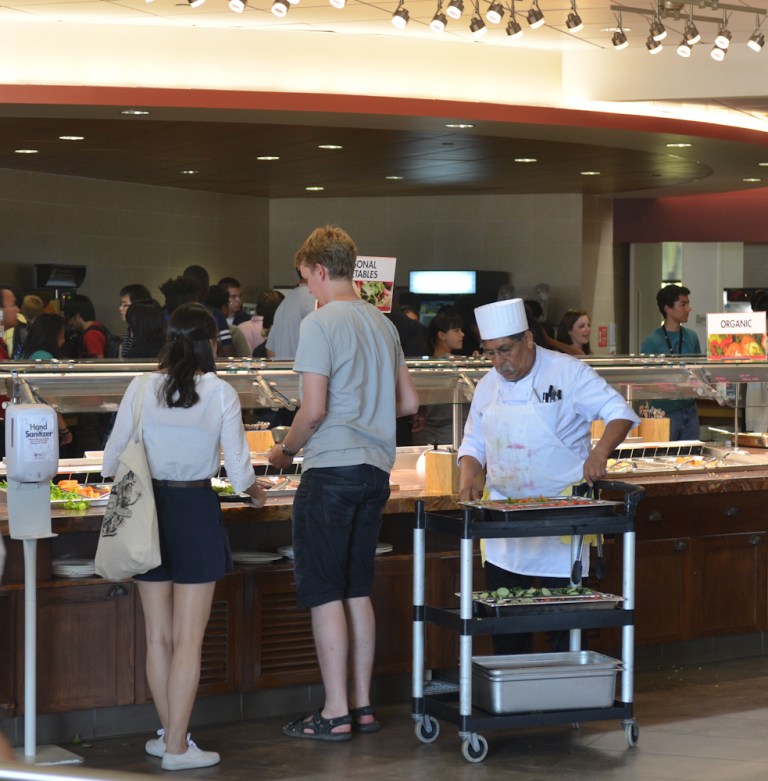With 12,000 meals being served everyday at 11 different on-campus dining halls, there is an immense amount of food that flows through the Stanford dining hall kitchens and into students’ stomachs on a daily basis. Although some amount of food waste is impossible to avoid, the dining halls do their best to limit the impact of their leftovers.
“Reducing food surplus can be challenging in an all-you-care-to-eat dining hall environment,” Executive Director of Communications for Residential and Dining Enterprises (RD&E) Jocelyn Breeland wrote in a statement to The Daily. “This type of operation means that we will inevitably produce more food than will be consumed, but we do not let that food go to waste. Any food remaining at the end of the meal period is either donated or turned into animal feed.”
Only specific foods can be donated, while the foods that are deemed unworthy for donation must be disposed of using alternate methods.
“Chefs determine what food can be donated based on food safety requirements,” Breeland said. “Foods that don’t freeze and reheat well — such as eggs and breakfast foods — are typically not donated.” The food that is fit for donation is then put into aluminum bins, weighed and stored in a freezer until it is ready to be picked up.
Twelve on-campus eateries, ranging from student dining halls to cafes and restaurants, are currently active in Stanford’s food donation program, according to Breeland. Catered events as well as athletic concessions also usually participate in the program.
“We donate football, basketball and baseball — the big three sports at Stanford — concessions almost every game,” co-director of Students for a Sustainable Stanford and volunteer for Stanford Project on Hunger (SPOON) Chris LeBoa ’19 said. “After the games, especially for football, we can get up to 500 or 600 pounds of leftover food for donation. A lot of the homeless shelters don’t have kitchens, so what is really nice about these leftovers is that we can drop off the donations, and [the guests] can just eat the hot dogs or pizza hot without any preparation.”
The donations are distributed to seven different organizations around the Bay Area, according to Breeland. One of the organizations that Stanford donates to is the Ecumenical Hunger Program (EHP), based in East Palo Alto. EHP sends a driver to pick up food from Stanford at least once a week, according to Program Supervisor Lakesha Roberts. In addition to the weekly pick-ups, Stanford also tends to make a large donation to EHP around the beginning of summer.
“At the end of the school year, we also kinda clean up from the dining halls and do one big pickup,” Roberts said. “That’s just because everyone is closing down, and they have a lot of food.”
Even individual students have started to donate their unwanted leftovers.
“We’ll also go around to some of the houses on campus, and we’ll take any unopened food that [the residents] have that they want to donate since, you know, everyone’s moving out for the summer,” Roberts said.
EHP redistributes much of the donated food on-site at their East Palo Alto location, but they also sponsor events where they give guests some of the donated food.
“A lot of our families like to take the prepared food so they don’t have to cook dinner; they can just pop the tray into the oven,” Roberts said. “We also do a hot meal every Wednesday at St. Francis of Assisi,” a church in East Palo Alto, “so we use a lot of that prepared food for that dinner because it’s already prepared in pretty large quantities and there’s pretty good variety as well.”
In the future, LeBoa hopes that Stanford Dining will continue to grow its food donation program and set the precedent for a food-waste-free college campus.
“It would be great if we could set an example for other schools and have a donation program that they would look at and would encourage them to start a similar program,” LeBoa said.
In the meantime, the program needs all the volunteers it can get to maintain such a large operation.
“Sometimes we’ll have some leftovers from a game or event, and we can’t get a volunteer to drop off the food, so we just end up wasting the food,” LeBoa said. “We are always looking for more volunteers to add to our email list of around 100 volunteers right now. It’s pretty low-commitment, and they just sign up to help drop off food whenever they are available.”
Contact Eric Epstein at ericrepstein ‘at’ gmail.com.
